
A naturalistic enclosure for Coleonyx
|
Care
As with all reptiles, captive Banded Geckos must have basic needs of food, water, temperatures and humidity met to thrive, but fortunately for the keeper, these are all quite simple to provide.
Housing for Banded Geckos can be very simple, or very elaborate. Whether you choose to house your gecko in a plastic box with minimal furnishings, or an elaborate bioactive display, certain options must always be available to the animals. Wild Banded Geckos are not exposed to all of the extremes of the environment in which they live, but rather control their individual microclimate. The ranges of preferred microclimate are what we are trying to provide in captivity. A 140F ground surface temperature certainly exists in Coleonyx habitat, but if the geckos avoid it at all costs, there is no need to recreate it in a captive environment.
|
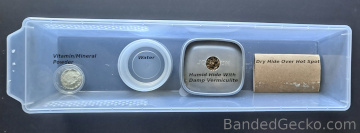
5qt Hatchling/Quarantine set up (18L x 5W x 3.5H)
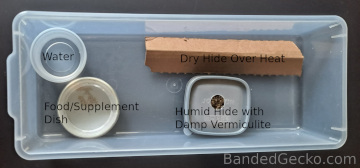
8qt tub for a single established adult (18L x 7.375W x3.5H)
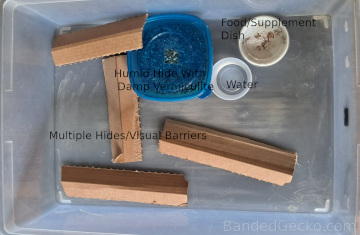
28qt Communal Enclosure for breeding groups (24L x 16W x 5H)
|
Housing
Although the American Banded Geckos come from dry habitats, clean water should be available at all times. In a simple tub setup, this can be easily provided with a small condiment cup. Spraying the enclosure occasionally with a spray bottle may be necessary, as the water droplets offer a more natural source for geckos that are not accustomed to drinking from a water dish.
A humid hide must be available to the geckos at all times. Although they are most often associated with the deserts of the American Southwest, the microclimate of Coleonyx is often under rocks or debris, where moisture is retained and humidity levels are much higher than on exposed ground. This humidity is necessary for shedding, and helps the gecko retain moisture it has taken in, preventing dehydration and death. In communal enclosures, the humid hide will be the chosen area for gravid females to deposit their eggs. Additional hides and cover should be used throughout the enclosure, and particularly over the warmest area.
A vitamin/mineral supplement should be available at all times, but some people prefer to dust feeder insects instead. A small dish of supplement will be used as needed, so I prefer to provide it. There are many options available, but I prefer Repashy Calcium Plus.
Housing groups of Coleonyx is similar to individuals, but more space and hides become necessary. I use a larger humid hide/laying box so all of the adults can use it at the same time if needed. I also offer multiple dry hides so animals can avoid each other if they choose.
Regardless of enclosure size, I prefer not to use a substrate. Banded Geckos use scent marking as a means of communication, and hides carry this scent. I prefer to move furnishings to a clean tub and clean the soiled tub later. It's also easier to monitor stools or get samples for testing without a substrate.
|
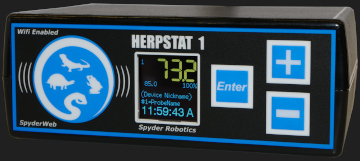
Thermostat with WiFi monitoring and control
|
Temperature
A temperature gradient is vital for reptiles, as they are unable to regulate their own body temperature. I offer my geckos a cool end in the 70s, with a hot spot provided by heat tape at 95F. I prefer long enclosures so that a wider temperature gradient can be achieved, giving the geckos more options.
In a minimalistic tub enclosure, heat should be provided by heat tape or heat cable. A thermostat is needed to regulate the temperature. With naturalistic setups, low wattage halogen spot bulbs provide a hot spot, and LED or fluroescent lighting can be used over the rest of the tank.
|
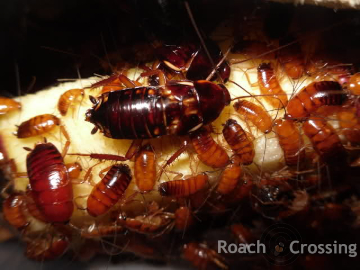
Red Runner/Turkestan Cockroaches (Blatta lateralis)
|
Feeding
Banded Geckos will readily eat any suitably sized insects. For hatchling Texas Banded Geckos (C brevis), this includes fruit flies and dwarf isopods. Adult Barefoot Geckos (C switaki) can easily consume small superworms. I offer a variety of insects 2-3 times weekly. Mealworms, isopods and roaches make up the bulk of the diet, and feeder insects are fed a variety of vegetables, with an emphasis on carrots and sweet potatoes for Vitamin A and beta carotenes, which are often lacking in commercial gutloads.
|

